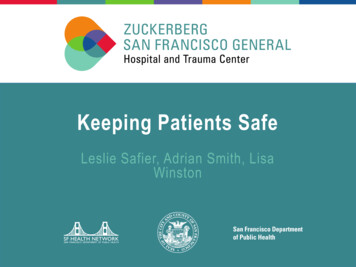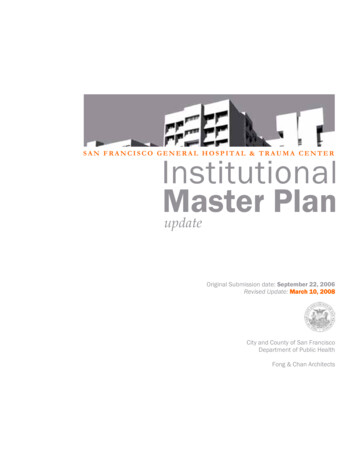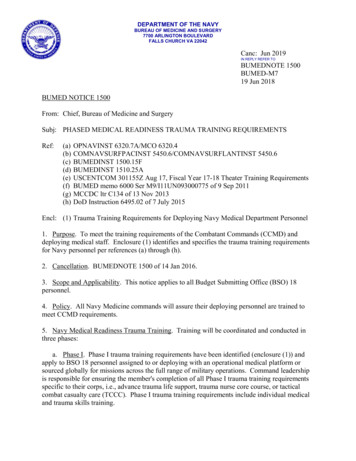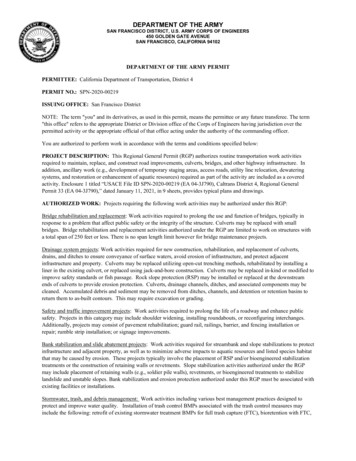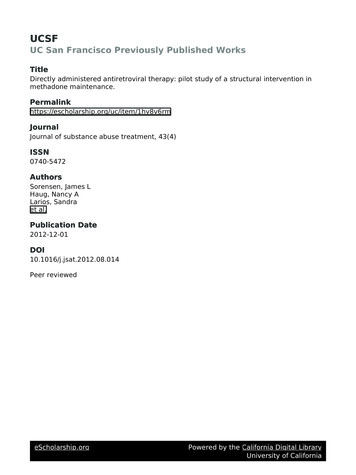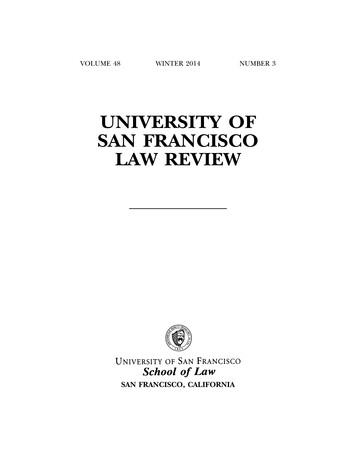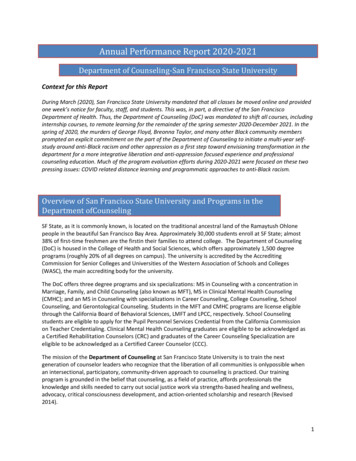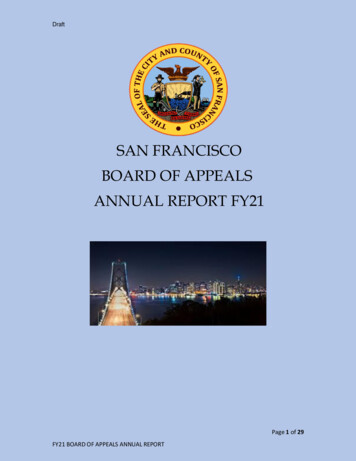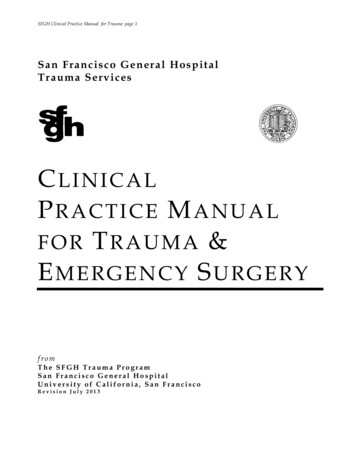
Transcription
SFGH Clinical Practice Manual for Trauma page 1S an Fran c is c o Gen eral Hos p italTrau ma S ervic esCLINICALPRACTICE MANUALFOR TRAUMA &EMERGENCY SURGERYfromThe SFGH Trauma ProgramSan Francisco General HospitalUniversity of California, San FranciscoRevision July 2013
SFGH Clinical Practice Manual for Trauma page 2PREFACEThis manual has been prepared specifically for members of the surgical house staff at San FranciscoGeneral Hospital providing care for trauma patients. It is designed to define and clarify servicecoverage issues, trauma team activations, admissions, transfers, initial evaluations, documentation,interactions with consultants, and issues related to performance improvement. SFGH is the soleprovider of organized trauma care for the City & County of San Francisco and northern San MateoCounty, and also provides a disproportionate share of emergency care throughout the county.Trauma patients are transported to SFGH, not by choice, but by virtue of the actual and potentialinjuries they have sustained. SFGH, operating as a Level 1 Trauma Center under the CaliforniaCode of Regulations, Title 22, is obligated by regulatory law to provide specific services andresponses to critically injured patients. Many of the requirements included in this manual are basedon this regulatory law, or requirements set forth by the American College of Surgeons Committeeon Trauma. As in any complex organization involving patient safety, consistency & redundancyare critical elements. As a member of the trauma team at the only designated Trauma Center in SanFrancisco, it is important that you appreciate the importance of the role you play in regional publicsafety and the overall emergency medical response, a role which is unlike any other in a surgicalresidency program.In a separate document, a compendium of clinical management protocols for trauma has beenprovided. These protocols have been developed at SFGH and reflect current practice at thisinstitution. They are not intended to be used as a locked-in set of rules, but as guidelines which areapplicable to most, but not all clinical situations. The list of protocols is not yet complete, and moreare being added as time goes on. Major deviations from these management protocols, whileoccasionally necessary, must involve consultation with members of the SFGH surgical faculty.Copies of this manual are available on the UCSF Department of Surgery resident website.Additional copies may be obtained from the Department of Surgery at SFGH. In addition, some ofthese protocols are available via the SFGH/CHN intranet and linked to the SFGH Lifetime ClinicalRecord (LCR). More will be uploaded as time goes on. Each member of the resident staff will beresponsible for reviewing the Clinical Practice Manual thoroughly and being familiar with theguidelines, protocols, and practice patterns on the Trauma Service at SFGH. Senior housestaffshould also be familiar with the essential clinical management protocols for trauma. Questions andsuggestions should be directed to Patti O’Connor, the Trauma Case Managers, or the Trauma NursePractitioners, but any of the surgical faculty will be willing to provide clarification as needed. Thepractice of Trauma Surgery is challenging, fast paced, and can be extremely rewarding. It is hopedthat this manual will provide a framework around which you can better structure your clinicaleducation during your time at San Francisco General Hospital.Robert C. Mackersie, M.D., FACSProfessor of Surgery, University of California San FranciscoDirector of Trauma Services, San Francisco General HospitalJuly 5, 20013
SFGH Clinical Practice Manual for Trauma page 3CLINICAL COVERAGE: ATTENDING STAFFThe "Service Attending"As the result of reductions in house staff and the implementation of work hours restrictions, it wasnecessary to eliminate the old system of multiple surgical services. All surgical inpatients are nowadmitted and cared for as part of a single surgical service, generically referred to as the “TraumaService”, although elective and emergency general, vascular, and thoracic patients are alsoadmitted to this service. The service is covered at all times by an attending physician, the “serviceattending”, who will make AM rounds with the surgical team (or individually with the senior orChief resident) on a daily basis. The Service Attending is the “go-to” and continuity person for allpatients hospitalized on the Trauma Service, and will be available 24 hours a day during the periodof service coverage unless substitute coverage arrangements are made. Any problems that arise onhospitalized patients or established consults should be referred to the Service Attending. TheService Attending will serve as the attending-of-record for service in-patients in need of operativeprocedures, unless other arrangements have been made. In the event that the Service Attending isnot immediately available for acute emergencies that arise on service patients, the on-call attendingshould be contacted.The "ON-CALL" AttendingAs of July 2007, attending trauma call has been split into daytime (7am-6pm) and nighttimecoverage periods for weekdays. Weekends remain 24 hour coverage periods from 8am to 8am.The Service Attending and Trauma Fellow will cover weekday periods. In some cases, the ServiceAttending or Fellow will also cover the remaining nighttime period (6pm-9am), but more often thisperiod will be covered by a separate attending. It is important for the senior resident on-call tocheck the published call schedule and know which attending is scheduled to cover. The On-callAttending will be responsible for covering all new admissions, new urgent/emergent consults,trauma resuscitations, and trauma and non-trauma emergency operations. The on-call physician isimmediately available to respond to trauma and other surgical emergencies at all times and isusually phycially present in the building. The senior surgical house staffwill receive a laminatedcard with attending contact numbers (this is available from the administrative staff in theDepartment of Surgery at SFGH).The "Surgeon-of-record"While day-to-day house staff supervision, progress note documentation, and routine decisionmaking for service patients will be provided by the Service Attending, the surgical staff memberwho attends at an elective or emergency operative procedure generally follows these patients alsoand serves as the attending of record and the major decision-maker for subsequent patient care,unless other arrangements have been made between individual attendings. In less severe,uncomplicated non-operative cases, (e.g. mild pancreatitis, short-stay orthopedic injuries, etc.), theService Attending typically assumes care of the patient, and acts as the attending-of-record. It is theresponsibility of the Service Attending, not the house staff, to re-direct any questions regardingmajor therapeutic decisions to the appropriate surgeon-of-record as appropriate.Sub-specialty Surgical Attending ConsultantsDepartment of Surgery attending consultants are available for special problems involving burns,thoracic, vascular, pediatric surgery, and surgical critical care. All consultations made for sub-
SFGH Clinical Practice Manual for Trauma page 4specialty care involving acute or in-patient trauma problems should be cleared with either the oncall attending or the service attending. Sub-specialty consultants are:Cardiothoracic:Arthur Hill, M.D.Pediatric trauma:Peggy Knudson, M.D.CLINICAL COVERAGE: TRAUMA FELLOWThe SFGH Trauma Fellowship is a one year, non-ACGME clinical fellowship in trauma andemergency surgery. The SFGH Trauma Fellow is typically a board certified/board eligible generalsurgeon, a board-eligible surgical Intensivist, and an active member of the SFGH Medical Staff. Thetrauma fellow acts as a junior attending surgeon, and provides trauma attending coverage, withidentified faculty back-up, 4-6 nights/month. As of July 1, 2010 the full time SFGH trauma facultywill take in-house call with the trauma fellow, but all relevant clinical decisions should first involvethe trauma fellow rather than the in-house attending (e.g. please do not bypass the trauma fellow).The fellow will also serve, typically later in the academic year, as the Trauma Service Attending,and may act as the surgeon-of-record for those operative and major non-operative cases they admit.CLINICAL COVERAGE & RESPONSIBILITIES: HOUSE STAFFThe Chief Resident (PGY V)The Chief Surgical Resident on the Trauma team will have clinical responsibilities similar to those ofthe ‘Senior’ surgical residents, but will also have overall responsibility for the service, and all of thetrauma in-patients at San Francisco General Hospital. The ‘Chief’ will provide more seniorsupervision, as needed, for surgical resident team, and ensure its smooth operation. The ChiefResident will take in-house trauma & emergency call in accordance with established call schedulesand compliant with house staff work hour limitation. The Chief Resident is responsible formaintaining a thorough knowledge of all service patients, particularly ICU and other higher riskpatients. The Chief Resident, when on trauma call, is responsible for responding immediately to all‘911’ and ‘900’ level activations In the event the Chief is involved in elective surgery or some othernon-emergent activity that might interfere with an immediate response to a ‘911’ trauma teamactivation (TTA), it is his/her responsibility to ensure that either the Trauma Fellow or a PGYIVlevel resident will respond instead. Neither a PGYII nor a PGYIII level surgical resident maysubstitute for a Chief Resident or a Senior resident on ‘911’ or ‘900’ level trauma team activationsunless specific arrangements are made with the on-call attending or trauma fellow.The Senior Residents (PGY IV)The ‘Senior’ surgical residents on the Trauma service will take in-house call in accordance withestablished call schedules and in compliance with house staff hours limits, typically on 12 hourrotations (days and nights), and provide coverage for operative procedures as needed. The post-callsenior resident will conduct sign-out rounds with the incoming senior resident. The ‘Seniors’ willrespond immediately to all ‘911’ and ‘900’ TTAs during their on-call periods In the event the SeniorResident is involved in elective surgery or some other non-emergent activity that might interferewith an immediate response to a ‘911’ trauma team activation (TTA), it is his/her responsibility toensure that either the Trauma Fellow, another PGYIV or V level resident will respond instead. BothChief and Senior residents will remain available at all times, either by phone or personal pager, foremergency call-back and multi-casualty incidents at SFGH, unless specifically excused by the Chiefof Surgery at SFGH.
SFGH Clinical Practice Manual for Trauma page 5The Junior Residents (PGY II, III)The ‘Junior’ surgical residents on the Trauma service will take in-house call in accordance withestablished call schedules and in compliance with house staff hours limits. They will also respondimmediately to ‘911’ level resuscitations and will be responsible for communicating any urgentpatient needs or serious condition immediately to the on-call Chief or ‘Senior’ resident. The‘Junior’ residents will assist w/ trauma resuscitations under the direction of the ‘Chief’ or ‘Senior’residents, including the transport & monitoring of patients to CT or angiography. The PGYIII levelresident may not act as a substitute for the Chief or ‘Senior’ resident for ‘911’ or ‘900’ level TTAsunless specific arrangements are made with the on-call attending or trauma fellow.Interns (PGY I)The surgical interns on the Trauma service will take in-house call in accordance with establishedcall schedules and in compliance with house staff hours limits. The surgical interns will respond to‘911’ trauma team activations, and assist with trauma resuscitations only as needed and directed bythe more senior surgical residents, or the ED attending staff.4th Year Medical Students (“Sub-interns”)Acting interns, “sub-I’s”, may respond to ‘911’ TTAs and assist in the same manner as interns, butgenerally should NOT be involved, unless specifically requested by a Senior or Chief resident, intrauma-related procedures conducted during the resuscitation.3rd Year Medical StudentsSurgery 110 students (3rd year) should NOT be involved in trauma resuscitation except as observers.Exceptions may be made under unusual circumstances, but only as directed by the Chief, Seniorresidents or the Trauma Attending surgeon.CALL-BACKS (emergency situations requiring return to the hospital):SFGH is the sole receiving facility for trauma in the City/County of San Francisco. There is nobackup facility, and SFGH does not ‘divert’ trauma patients. As such, SFGH must maintain a ‘surgecapacity’, and be able to manage an unexpected ‘bolus’ of high acuity trauma patients. For theattending-level staff, the call-back order is: 1) trauma fellow and/or service attending, dependingon the situation 2) pre-call attending 3) post-call attending. For the resident staff, the call-backorder is: 1) Trauma PGYIII resident or Chief resident depending on need. 2) pre-call PGYII resident3) off-call senior resident (rarely). While it is extremely rare that more than one or two call-backphysicians are needed, it is the responsibility of each member of the house staff, while onrotation at SFGH, to remain available by personal pager, cell phone, home phone, or some othermeans, in the event that return to the hospital becomes necessary. Special arrangements for outof-town travel may be made through the SFGH Chief of Surgery’s office. At the beginning of eachSFGH Trauma rotation, each house staff member (PGY II-V) will received a laminated card withcontact numbers for the SFGH surgical faculty, as well as the UCSF house staff.SIGN-OUTS & CONTINUITY OF CAREGaps in the continuity of care present one of the most serious problems in patient safety that existon a busy trauma/emergency service. These gaps have increased as the result of the 80 hour worklimits and an increasing amount of “shift work” scheduling. It is imperative that these inherentgaps in the transfer of care from one group of physicians to another be minimized throughcomprehensive, high-fidelity sign-outs & transfers. (see “Communication & the chain of
SFGH Clinical Practice Manual for Trauma page 6command”). Whenever possible, non-urgent interventions requiring timely follow-up (e.g. chesttube removal, central line insertion, etc) should be conducted so as not to span these continuitygaps. In specific terms, the following policies are in effect:1. Formal ‘off-service’ notes, briefly summarizing injuries, conditions, and clinical course, shallbe written for all patients transferred to other acute care services at SFGH. Theneurosurgical service will not accept patients without these notes.2. The practice of writing “Call Trauma for post-op orders” on the part of the orthopedicservice is no longer acceptable. For patients hospitalized on the trauma service needingorthopedic procedures, a set of post-operative orders is needed, but will be written by thetrauma service only following direct and comprehensive communication between a seniormember of the orthopedic operating team, and a member (PGYII, III, IV, C) of the traumateam.3. Formal sign out between covering residents will take place at 6AM (prior to formal roundsbeginning at 6:30AM) and again at 6PM (prior to sign out rounds beginning at 6:30PM)CLINICAL COVERAGE: TRAUMA NURSE PRACTITIONERSSFGH currently employs twelve (12) trauma nurse practitioners on the Trauma/GS service. Theyare highly trained providers who function under the supervision of the SFGH Trauma MedicalDirector and a Senior Hospital Administrator. Nurse practitioners are members of the SFGHancillary medical staff and are licensed and approved to independently prescribe medications andtreat patients, within a defined scope of practice. Their responsibilities are are split betweenTrauma and General Surgery patients The NPs may admit and assume primary care of patients,assist with discharge planning, see clinic patients independently, and act as a consultative liaison torehabilitation and other services. The NPs also assist with many aspects of the management ofICU patients related to the patient’s critical illness (e.g. DVT prophylaxis monitoring, rehabconsults, etc.), and help coordinate care. All NP in-patient care activities must be consistent andcoordinated with the overall patient management plan as directed by the Trauma Attending orTrauma Chief/Senior Resident.TRAUMA TEAM ACTIVATIONS‘900’ and ‘911’ Level ActivationsCriteria for ‘900’ and ‘911’ trauma team activations are attached (attachment2). These activationsrequire an immediate response on the part of the Chief or ‘Senior’ on-call surgical residents. Insofaras the majority of ‘900’ activations require hospital admission, the Trauma Service, unless theyindicate otherwise, will be primarily responsible for these patients. ‘911’ activation patients arecared for collaboratively between the Trauma and EM services but are the primary responsibility ofthe EM service until it is clear that they will need admission at which time the primaryresponsibility will switch to the Trauma Service. Unless, and until it is established that a ‘900’ or‘911’ patient will not require hospital admission, the senior members of the Trauma Service(Attending, Chief, or ‘Senior’ resident) will be the primary decision makers in the course ofmanaging these patients. The conduct for ‘900’ and ‘911’ resuscitations is detailed in the TraumaTask Force Personnel and Organization document (attachment 9).Any patient who presents to the ED with, or develops indications for, a higher level of TTA thanwas originally made, will automatically trigger a second, upgraded TTA. A TTA upgrade may betriggered, at any time, and regardless of the presence in the ED of senior trauma team members. It
SFGH Clinical Practice Manual for Trauma page 7will be the responsibility of the ED staff and the trauma team members in attendance to ensure thatthe upgrade is recognized and a page is sent.Mandatory Trauma Attending Response: The ‘900’ Level ActivationThe American College of Surgeons guidelines for a Level 1 Trauma Center requires that a boardeligible or certified, trauma-qualified surgeon be present in the ED for major resuscitations. A ‘900’page is triggered by the ED charge nurse, based either on pre-hospital or on-arrival patient status.This page is received through the house staff pager and also on specially designated ‘900’ pagers,carried by the on-call trauma attending and the on-call attending anesthesiologist. Traumaattendings will respond to the ED within 15 minutes of this page. ‘900’ level activations may betriggered at any time during the initial resuscitation, and are based on confirmed hypotension(BP 90mmHg), respiratory distress (or need for intubation), gunshot wounds to the neck or torso,or for multiple patients & mass casualty incidents as detailed in the trauma triage criteria. In casesof severely injured patients or those in shock where no Trauma Attending is present, the Senior orChief resident present should immediately request activation of the ‘900’ page, or page/call theattending surgeon directly.Trauma Activations with Minor or Unclear MechanismsPatients presenting to the ED with seemingly minor or unknown mechanisms and altered (911type) physiology will trigger a ‘911’ TTA if any reasonable suspicion of a traumatic etiology exists.This determination will be made collaboratively by the ED attending and ED Charge Nurse.TRAUMA RESUSCITATIONS: ROLES & RESPONSIBILITIES OF THEEMERGENCY DEPARTMENT AND TRAUMA TEAMSLeadership, Decision Making, and the “Team Approach”Each resuscitation must have a “team leader”, who organizes the team and coordinates theresuscitation, as well as someone, typically the most experienced physician, making the majordiagnostic and therapeutic decisions. Occasionally, this may be the same person. Collaborationbetween members of the Trauma (surgical) team and the Emergency Medicine (EM) team iscritically important, and should involve all physicians providing care during a trauma resuscitation.The following are guidelines, not policy, that apply to these roles and responsibilities. As with anyguideline, a certain flexibility should be maintained in their application, and adjustments made asneeded, based on physician experience, patient volume & acuity, and individual injuries: For all trauma team activations and consults there should be a service primarily responsiblefor the care of the patient and a consultative service. For patients anticipated not to requirehospital admission, the EM team will act as the primary service and the trauma team theconsultative service. This will be the case for most ‘911’ activations. For patients anticipatedto require hospital admission, the Trauma team will act as the primary service and the EMteam the consultative service. This will be the case for most ‘900’ activations. For ‘900’ level activations the responsibilities for team leadership are shared between theTrauma team and the EM team on an alternating-day basis (odd days EM team, even days Trauma team). While a collaborative approach to management between the EM andtrauma teams is expected, the ultimate responsibility for major diagnostic & therapeuticdecisions rests with the trauma team. If a ‘900’ patient, in the course of evaluation, is notfound to have indications for hospital admission, the EM team becomes the primary teamand assumes primary responsibility for major diagnostic and therapeutic decisions,regardless of initial team leadership roles.
SFGH Clinical Practice Manual for Trauma page 8 At the conclusion of each resuscitation, clear delineation of primary and consultative patientcare teams shall be made by the EM and Trauma services. If, at any time and for any reason, the EM resident is unable to act as an effective ‘teamleader’ or declines the role, the role will be assumed by the trauma Chief or Senior resident.If, at any time, the ED resident, as “team leader” for ‘900/’911’ activations, is unable orunwilling to follow the major diagnostic and/or therapeutic plans delineated by the traumateam, the role of ‘team leader’ will be assumed by the trauma Chief or Senior resident orTrauma Attending. In the absence of a Trauma Senior or Chief resident, or Trauma Attending, the EM team,under the direct supervision of the EM Attending, will assume primary responsibility for a‘900/911’ resuscitation and direct all major therapeutic and diagnostic decisions. Airway management, including tracheal intubations and rapid sequence inductions (RSI)will be the responsibility of the anesthesiology team, working in conjunction with theresuscitation “team leader” and the Trauma team. All related medications administeredduring a trauma RSI will be prescribed by the anesthesiology team, unless delegatedotherwise. Airway management, in the absence of the anesthesiology team, will be theresponsibility of the EM attending. Sub-specialty services, neurosurgery, orthopedics, pediatrics, and consulting services duringtrauma resuscitations will work collaboratively with the trauma team and resuscitation“team leader”. Major decisions based on sub-specialty consultation as well as any subspecialty related procedures must be made or performed in consultation with the traumateam. Disputes between members of the resuscitation team, including Trauma and EM members,regarding patient management issues, will be resolved by the Trauma Attending as needed.Trauma-related ProceduresTrauma-related procedures are shared between the Trauma team and the EM team on an alternateday basis with the team not providing team leadership typically being responsible bedsideprocedures (odd days trauma team, even days EM team). The following guidelines apply toprocedures performed during resuscitation in the ED by the trauma team or ED team: All procedures must be supervised by an ED attending, Trauma Attending, or TraumaSenior/Chief resident Strict aseptic technique, including wide prep & draping, should be followed at all times. Procedures in critically injured patients should not be performed, even if supervised, byhouse staff lacking complete familiarity and substantial experience with that procedure, orone very closely related. 3rd year medical students should NOT be performing any procedures on acute traumapatients. Resuscitative thoracotomies should be performed by Trauma Senior or Chief residents orTrauma Attending surgeons, unless specifically directed otherwise by the TraumaAttending. In the event that none of the senior trauma team members are available ,(beeper malfunction, mass casualty events, etc), and the patient has injuries consistent withpossible cardiac tamponade, the EM Attending may assume responsibility for personallyperforming these procedures. Open cricothyroidotomy is the preferred ‘surgical’ airway for most trauma patients, andshould be performed by PGYIII level surgical resident or higher, with appropriate traumaattending supervision. Open cricothyroidotomies may be performed by a member of the EDresident team only with direct supervision by the trauma attending surgeon.
SFGH Clinical Practice Manual for Trauma page 9 Needle cricothyroidotomies may be performed by a member of the anesthesiology team orED team only at the discretion of the Trauma Attending, or at the discretion of the EDAttending if the Trauma Attending is not available. Endotracheal intubations should beperformed by a member of the anesthesiology team, unless specifically directed otherwiseby the Anesthesiology Attending. In the absence of the anesthesiology team, the EMAttending will assume responsibility for airway management and intubation.ROUNDS, PATIENT ADMISSIONS, & CONSULTATIONSBasic Criteria for Admission to the Trauma ServiceAll patients requiring hospital admission on the basis of demonstrated or suspected acute traumaticinjury will be initially admitted to the Trauma Service until a complete diagnostic evaluation iscompleted and appropriate service transfer arrangements, if needed, can be made. All ICUadmissions for trauma patients should be initially to the Trauma Service except as noted below forisolated traumatic brain injuries. Patients with isolated sub-specialty system injuries (e.g. multiplefacial fractures) requiring ICU admission will be admitted to the trauma service, and not the ICUservice. Pediatric patients requiring hospital admission will be admitted to the trauma service withactive daily pediatric service involvement. On occasion, very young patients (less than 4-5 years ofage) may be admitted to the pediatric service with active daily trauma service involvement.Exceptions to the rules above include the following: Isolated orthopedic injuries to the extremities without suspicion of associated abdominal,vascular or neurological injury may be admitted to the orthopedic service (see guidelines fororthopedic patients in attachments). Minor isolated head injuries, cleared by the Trauma service, and not requiring ICU or 4Badmission may be admitted to the neurosurgery service. Serious isolated traumatic brain injuries, completely cleared of associated injuries by theTrauma service, seen & examined & cleared by the on-call Trauma attending, and seen &examined by the neurosurgery attending or Chief resident may be admitted to theneurosurgery service if OK’ed by both the Trauma Attending and Neurosurgical Attendingor Chief. Pediatric patients cleared by the Trauma service for discharge, but admitted separately bythe pediatric service On rare occasions, patients with severe or complex underlying co-morbidity (e.g. severeCAD, COPD) may require admission precipitated on the basis of a minor or moderate injury.Admission to a subspecialty service may be appropriate, but should be cleared with theAttending Trauma Surgeon on-call.Trauma ConsultsTrauma consults are requested by the ED staff or sub-specialty services, and involve non-traumateam activation patients. Patients meeting the following guidelines require evaluation by a SeniorTrauma resident or above: Any patient with a trauma-related mechanism requiring ICU or Step-down admission by anon-trauma service. Any patient with major or minor mechanism with any complaints of abdominal pain orsigns of abdominal injuries. Patients with major mechanism trauma not resulting in TTA, who require hospitaladmission for any reason. All trauma patients being transferred to SFGH from out-of-region
SFGH Clinical Practice Manual for Trauma page 10Surgical Sub-specialty ConsultationsAdditional consults may be requested by the on-call trauma team, as needed. Burn patients requiring admission: Mandatory notification of the on-call Trauma attendingfollowed by notification of the on-call burn attending. Blunt aortic injury: Mandatory notification of the on-call trauma attending followed bycontacting the cardio-thoracic on-call surgeon. If SFGH on-call staff are unavailable, then theUCSF-Parnassus campus on-call CT surgeon should be notified. Axial spine injuries: Mandatory notification of the on-call spine team. Complex pediatric trauma: Mandatory notification of the on-call trauma attending followedby notification of the pediatric surgeon on-call. Urology: For significant injuries to the kidney, ureters, bladder, or urethra Vascular: Vascular injuries are normally managed by the trauma attending. Any additionalconsultation for vascular surgery should be directed by the trauma attending.EMERGENCY DEPARTMENT DISPOSITIONCritical Care Patients (intubated and non-intubated)Current hospital policy dictates that intubated patients will be physically admitted to an ICU bedwithin 30 minutes of ICU notification. The E.D. charge
As a member of the trauma team at the only designated Trauma Center in San Francisco, it is important that you appreciate the importance of the role you play in regional public . Director of Trauma Services, San Francisco General Hospital July 5, 20013 . SFGH Clinical Practice Manual for Trauma page 3 CLINICAL COVERAGE: ATTENDING STAFF The .
